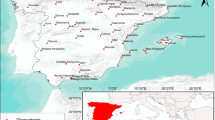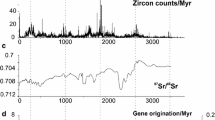Summary
The catalogue of sea-floodings in Venice, accurately reconstructed for a period of 12 centuries (interval: 872–1996) has been analysed according to the Cantor Dust method. This provides a means of testing whether clustering in time is a scale-invariant process: if the fraction R of the intervals of length t containing flooding events is related to the time interval by: R∼t (1−D), then the fractal clustering is occurring with fractal dimension D (0<D<1). The main result is the evidence for a gradual increase of the fractal clustering starting from 1914, when the soil subsidence of the lagoon basin determines an increase in its hydrodynamic response to the marine forcing with a gradual increase of flooding occurrences.
Similar content being viewed by others
Author information
Authors and Affiliations
Additional information
Received October 1, 1996 Revised September 10, 1997
Rights and permissions
About this article
Cite this article
Mazzarella, A. The Time Clustering of Floodings in Venice and the Cantor Dust Method. Theor Appl Climatol 59, 147–150 (1998). https://doi.org/10.1007/s007040050020
Issue Date:
DOI: https://doi.org/10.1007/s007040050020




